CILDO MEIRELES EN PALMA DE MALLORCA
ALTTRA Foundation organizes in three spaces in Palma, on the island of Mallorca, an exhibition that addresses the theme of insularity and its role and idiosyncrasy in a globalized world through several works by Cildo Meireles (Rio de Janeiro, Brazil, 1948). The works chosen, corresponding to five different periods of the artistic production of one of the referents of Brazilian neo-conceptualism, trace a journey through some of the themes and investigations that the artist has developed throughout his life, from fortune and chance to the perception of the physically invisible but perceptible, such as sound, or the relationship between space and its use.
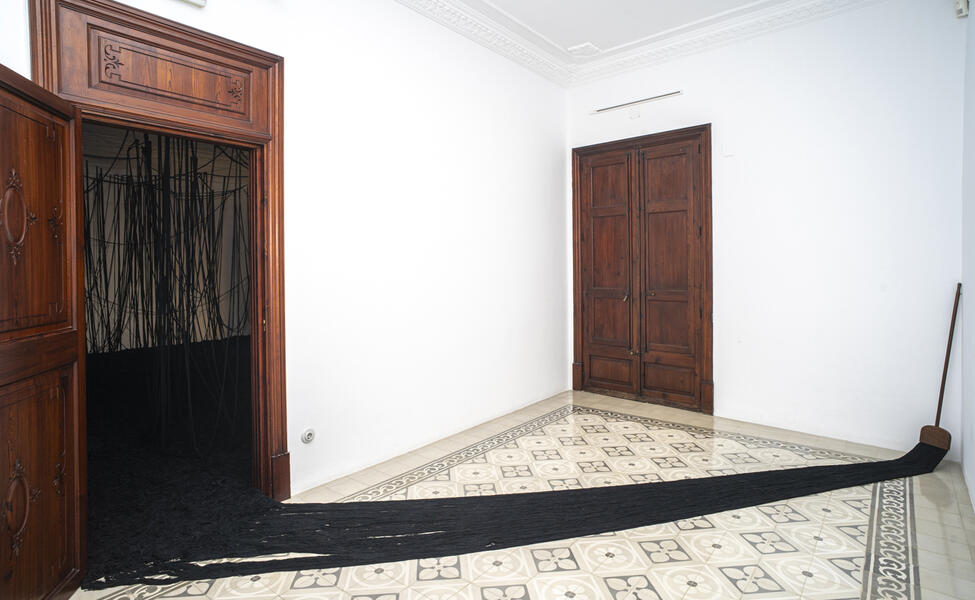
The exhibition uses several emblematic locations of the Balearic capital to enhance the concepts of integration and history, but also the quality of public space or the historiography of the city. In this framework, the exhibition aims to trace the bases of thought through the allegories that show the works to be able to analyze the contradictions that ride the insular geography.
Thus, Rio Oír (1976-2009-2011) delves into the relationship of the territory with water, surrounded and defined by the element, but suffering from the problem of drinking water; Fio (1990-1995) poses an analysis of the difference between the value of use and economic value, while the 2,200 km of cotton thread of La Bruja (1979-1981) delves into a chaos that seems to symbolize the activity around the flow and thought. Alto (1977 - 2024), on the other hand, also approaches chaos and order from the crossed result of loudspeakers and frequencies opposite in intensity and size.
Cildo Meireles can be visited until January 11, 2025 at the Col-legi d'Arquitectes de les Illes Balears, Estudi General Lul-lià and Espai Buit, Palma de Mallorca (Spain).
May interest you
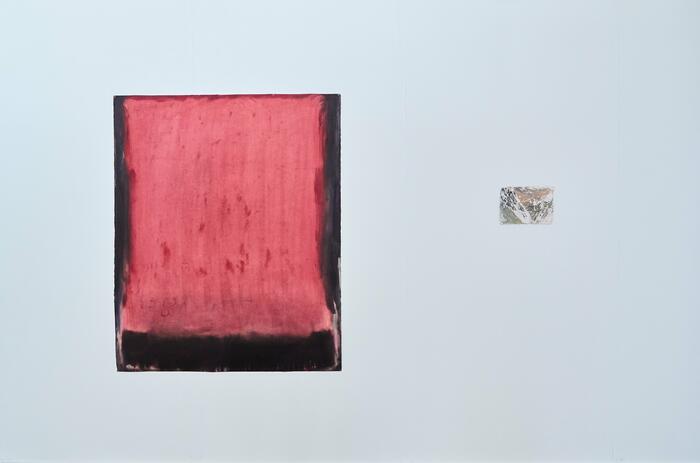
Arte al Día takes a look at the curatorial selection that highlights works by Ibero-American galleries in the NEXT, RADAR and Main sections of Pinta Miami. The curatorial team for the 2024 edition of the fair is integrated by Irene Gelfman -global curator of Pinta and co-curator of FORO and Special Project-, Giuliana Vidarte -curator of NEXT and co-curator of FORO and Special Project- and Angelica Arbelaez -curator of RADAR.
CURATORS' PICKS: THREE PROPOSALS AT PINTA MIAMI
Arte al Día takes a look at the curatorial selection that highlights works by Ibero-American galleries in the NEXT, RADAR and Main sections of Pinta Miami. The curatorial team for the 2024 edition of the fair is integrated by Irene Gelfman -global curator of Pinta and co-curator of FORO and Special Project-, Giuliana Vidarte -curator of NEXT and co-curator of FORO and Special Project- and Angelica Arbelaez -curator of RADAR.

Arte al Día takes a look at the curatorial selection that highlights works by Ibero-American galleries in the NEXT, RADAR and Main sections of Pinta Miami. The curatorial team for the 2024 edition of the fair is integrated by Irene Gelfman -global curator of Pinta and co-curator of FORO and Special Project-, Giuliana Vidarte -curator of NEXT and co-curator of FORO and Special Project- and Angelica Arbelaez -curator of RADAR.
CURATORS' PICKS: THREE PROPOSALS AT PINTA MIAMI
Arte al Día takes a look at the curatorial selection that highlights works by Ibero-American galleries in the NEXT, RADAR and Main sections of Pinta Miami. The curatorial team for the 2024 edition of the fair is integrated by Irene Gelfman -global curator of Pinta and co-curator of FORO and Special Project-, Giuliana Vidarte -curator of NEXT and co-curator of FORO and Special Project- and Angelica Arbelaez -curator of RADAR.

Isabel Hurley Gallery in Malaga dedicates an exhibition as a tribute to Alberto Borea (Lima, Peru, 1971- ibidem, 2020). El negro estuvo aquí (2008-2013) goes through his last five years of production through a selection of representative works that were part of the solo shows Ruinas y ciudades, Mountains of America and Turista El Dorado, all of them exhibitions that the Peruvian made in this same gallery, in addition to the proposals made to be exhibited in Volta NY 2011 and ARCO 2013.
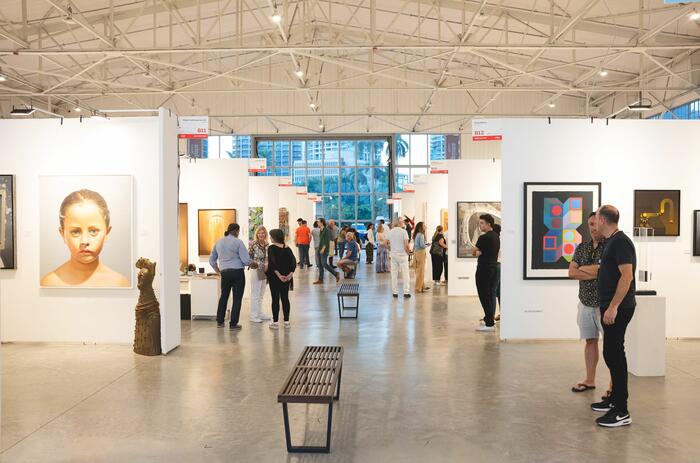
Since its foundation in 2007 in New York, Pinta has established itself as a key event in promoting Latin American, Spanish, and Portuguese art. What began as a boutique fair in the Big Apple has evolved into a global concept connecting artists, galleries, and collectors worldwide.
PINTA: A SUCCESS STORY IN LATIN AMERICAN ART
Since its foundation in 2007 in New York, Pinta has established itself as a key event in promoting Latin American, Spanish, and Portuguese art. What began as a boutique fair in the Big Apple has evolved into a global concept connecting artists, galleries, and collectors worldwide.
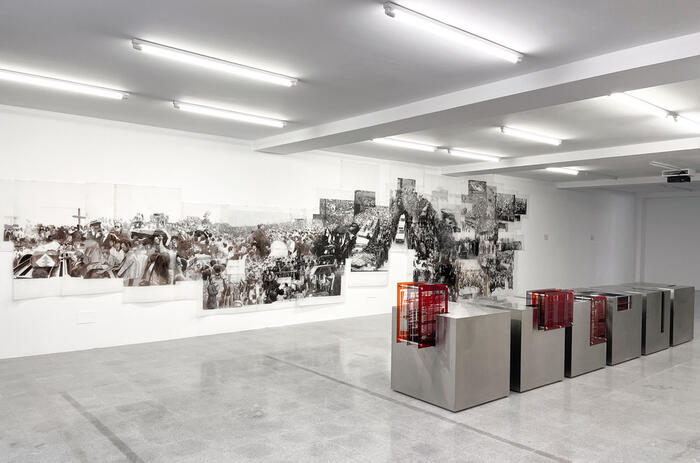
The work of Voluspa Jarpa (Rancagua, Chile, 1971) has had a very preeminent focus on the political concept surrounding archiving and its documents. Attracted to investigate more about its multiple meanings as a result of the declassification of secrets, specifically the one carried out by the Clinton administration regarding the 1973 coup d'état against Salvador Allende, the artist begins a discursive investigation on the importance of the archival support and the materiality it has as a political document, which leads her to qualify that presupposed legibility.
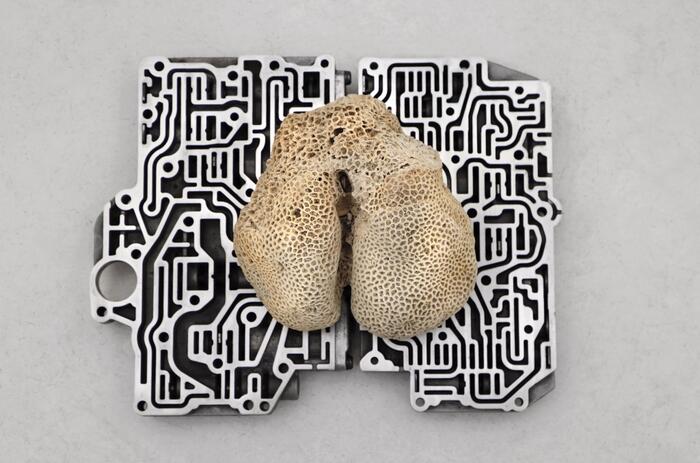
The work Nicolás Lamas (Lima, Peru, 1980) presents at The Goma Galery in his solo show Flujos atemporales/sedimentos cognitivos is circumscribed to his way of understanding relationships in a network of knowledge that involves the worlds of the natural and the cultural. Both spheres are the ones that lead him to use in his production processes different materials, artificial and organic, with which he gives life to hybrid elements that have an impact on the viewer's perception.
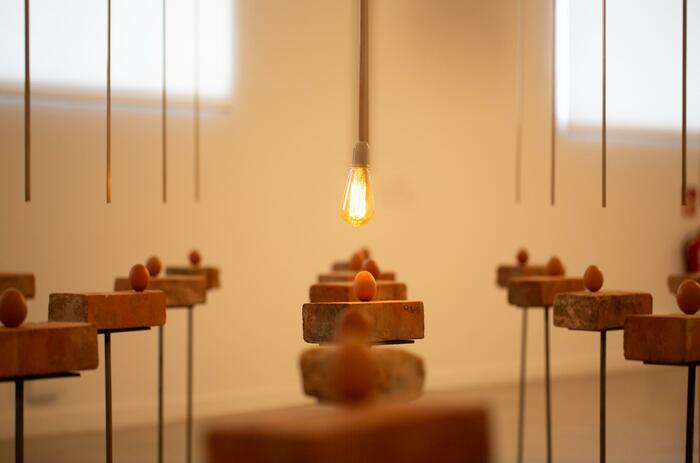
Contemplando es como fuimos cambiando (Contemplating is how we changed) is the exhibition, the first one in Spain promoted by an institution, that the CICC Tabakalera in San Sebastian is dedicating to Gabriel Chaile (San Miguel de Tucumán, Argentina, 1985), one of the most prominent names in contemporary Latin American sculpture. This proposal is intended to take an extensive look at his work, from his beginnings to his latest works produced in Lisbon, and which is recognizable by his monumental adobe, clay and metal pieces that reflect the morphology of the pre-Columbian ceramics of his native region.
GABRIEL CHAILE’S SCULPTURE AT TABAKALERA
Contemplando es como fuimos cambiando (Contemplating is how we changed) is the exhibition, the first one in Spain promoted by an institution, that the CICC Tabakalera in San Sebastian is dedicating to Gabriel Chaile (San Miguel de Tucumán, Argentina, 1985), one of the most prominent names in contemporary Latin American sculpture. This proposal is intended to take an extensive look at his work, from his beginnings to his latest works produced in Lisbon, and which is recognizable by his monumental adobe, clay and metal pieces that reflect the morphology of the pre-Columbian ceramics of his native region.

The São Paulo Museum of Art (MASP) presents the exhibition Serigrafistas Queer: Liberdade para as sensibilidades (Freedom for sensibilities) from December 13 to March 16, 2025. It addresses themes such as the struggle for reproductive rights, bodily autonomy, the political approach to the HIV crisis, and the celebration of diverse affections and identities.
ARGENTINE QUEER COLLECTIVE AT MASP: ACTIVISM, REPRODUCTIVE RIGHTS AND DIVERSE IDENTITIES
The São Paulo Museum of Art (MASP) presents the exhibition Serigrafistas Queer: Liberdade para as sensibilidades (Freedom for sensibilities) from December 13 to March 16, 2025. It addresses themes such as the struggle for reproductive rights, bodily autonomy, the political approach to the HIV crisis, and the celebration of diverse affections and identities.
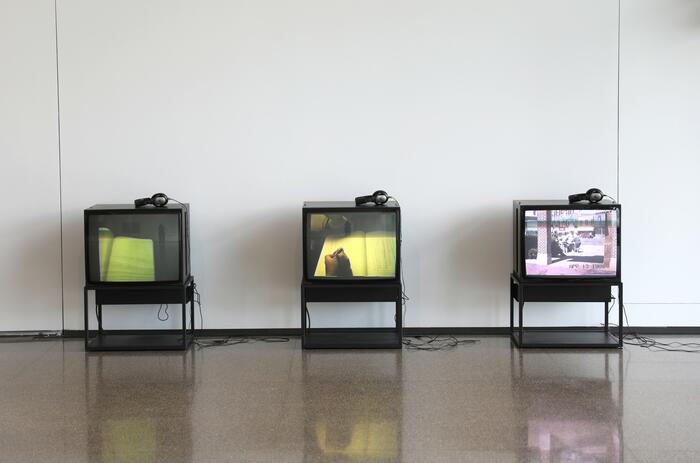
The exhibition Contar Rutinas (Counting Routines) dedicated by the Cerezales Antonino and Cinia Foundation to the work of Ana Amorim (São Paulo, Brazil, 1956) includes a selection of actions and performative works and installations that reflect the activity of the Brazilian artist from the 1980s to the present. The architecture of this exhibition is marked by the artist's daily conceptual and performative routines, reflecting their influence in the results of monumental dimensions.
ANA AMORIM'S REGISTER OF THE ROUTINE
The exhibition Contar Rutinas (Counting Routines) dedicated by the Cerezales Antonino and Cinia Foundation to the work of Ana Amorim (São Paulo, Brazil, 1956) includes a selection of actions and performative works and installations that reflect the activity of the Brazilian artist from the 1980s to the present. The architecture of this exhibition is marked by the artist's daily conceptual and performative routines, reflecting their influence in the results of monumental dimensions.
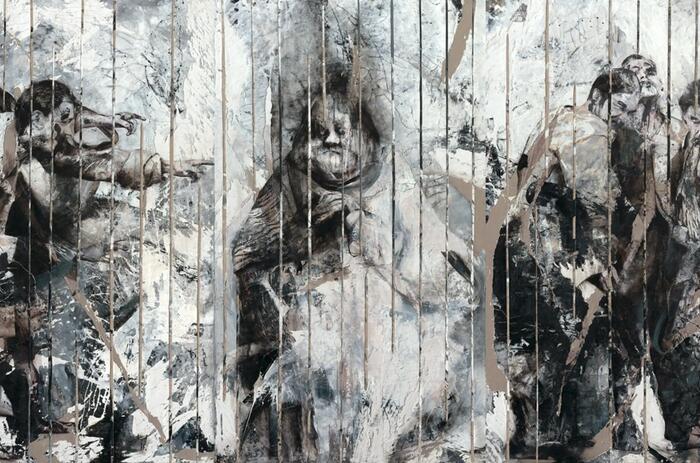
Goya's Los Disparates preceded, or marked, painting's entry into modernity. Beyond this historiographical note, the series by the Aragonese master captures with masterful imagery the vicissitudes of irony, sarcasm and the darkness of a reality that has lasted through time to the present day. The plates of his etchings become the surface that deposits this reality, and the result, once impregnated, works as a full reminder of the origin of our essence, our fears and our actions.
LITA CABELLUT IN DIALOGUE WITH GOYA
Goya's Los Disparates preceded, or marked, painting's entry into modernity. Beyond this historiographical note, the series by the Aragonese master captures with masterful imagery the vicissitudes of irony, sarcasm and the darkness of a reality that has lasted through time to the present day. The plates of his etchings become the surface that deposits this reality, and the result, once impregnated, works as a full reminder of the origin of our essence, our fears and our actions.

Arte al Día takes a look at the curatorial selection that highlights works by Ibero-American galleries in the NEXT, RADAR and Main sections of Pinta Miami. The curatorial team for the 2024 edition of the fair is integrated by Irene Gelfman -global curator of Pinta and co-curator of FORO and Special Project-, Giuliana Vidarte -curator of NEXT and co-curator of FORO and Special Project- and Angelica Arbelaez -curator of RADAR.
CURATORS' PICKS: THREE PROPOSALS AT PINTA MIAMI
Arte al Día takes a look at the curatorial selection that highlights works by Ibero-American galleries in the NEXT, RADAR and Main sections of Pinta Miami. The curatorial team for the 2024 edition of the fair is integrated by Irene Gelfman -global curator of Pinta and co-curator of FORO and Special Project-, Giuliana Vidarte -curator of NEXT and co-curator of FORO and Special Project- and Angelica Arbelaez -curator of RADAR.

Isabel Hurley Gallery in Malaga dedicates an exhibition as a tribute to Alberto Borea (Lima, Peru, 1971- ibidem, 2020). El negro estuvo aquí (2008-2013) goes through his last five years of production through a selection of representative works that were part of the solo shows Ruinas y ciudades, Mountains of America and Turista El Dorado, all of them exhibitions that the Peruvian made in this same gallery, in addition to the proposals made to be exhibited in Volta NY 2011 and ARCO 2013.

Since its foundation in 2007 in New York, Pinta has established itself as a key event in promoting Latin American, Spanish, and Portuguese art. What began as a boutique fair in the Big Apple has evolved into a global concept connecting artists, galleries, and collectors worldwide.
PINTA: A SUCCESS STORY IN LATIN AMERICAN ART
Since its foundation in 2007 in New York, Pinta has established itself as a key event in promoting Latin American, Spanish, and Portuguese art. What began as a boutique fair in the Big Apple has evolved into a global concept connecting artists, galleries, and collectors worldwide.

The work of Voluspa Jarpa (Rancagua, Chile, 1971) has had a very preeminent focus on the political concept surrounding archiving and its documents. Attracted to investigate more about its multiple meanings as a result of the declassification of secrets, specifically the one carried out by the Clinton administration regarding the 1973 coup d'état against Salvador Allende, the artist begins a discursive investigation on the importance of the archival support and the materiality it has as a political document, which leads her to qualify that presupposed legibility.

The work Nicolás Lamas (Lima, Peru, 1980) presents at The Goma Galery in his solo show Flujos atemporales/sedimentos cognitivos is circumscribed to his way of understanding relationships in a network of knowledge that involves the worlds of the natural and the cultural. Both spheres are the ones that lead him to use in his production processes different materials, artificial and organic, with which he gives life to hybrid elements that have an impact on the viewer's perception.

Contemplando es como fuimos cambiando (Contemplating is how we changed) is the exhibition, the first one in Spain promoted by an institution, that the CICC Tabakalera in San Sebastian is dedicating to Gabriel Chaile (San Miguel de Tucumán, Argentina, 1985), one of the most prominent names in contemporary Latin American sculpture. This proposal is intended to take an extensive look at his work, from his beginnings to his latest works produced in Lisbon, and which is recognizable by his monumental adobe, clay and metal pieces that reflect the morphology of the pre-Columbian ceramics of his native region.
GABRIEL CHAILE’S SCULPTURE AT TABAKALERA
Contemplando es como fuimos cambiando (Contemplating is how we changed) is the exhibition, the first one in Spain promoted by an institution, that the CICC Tabakalera in San Sebastian is dedicating to Gabriel Chaile (San Miguel de Tucumán, Argentina, 1985), one of the most prominent names in contemporary Latin American sculpture. This proposal is intended to take an extensive look at his work, from his beginnings to his latest works produced in Lisbon, and which is recognizable by his monumental adobe, clay and metal pieces that reflect the morphology of the pre-Columbian ceramics of his native region.

The São Paulo Museum of Art (MASP) presents the exhibition Serigrafistas Queer: Liberdade para as sensibilidades (Freedom for sensibilities) from December 13 to March 16, 2025. It addresses themes such as the struggle for reproductive rights, bodily autonomy, the political approach to the HIV crisis, and the celebration of diverse affections and identities.
ARGENTINE QUEER COLLECTIVE AT MASP: ACTIVISM, REPRODUCTIVE RIGHTS AND DIVERSE IDENTITIES
The São Paulo Museum of Art (MASP) presents the exhibition Serigrafistas Queer: Liberdade para as sensibilidades (Freedom for sensibilities) from December 13 to March 16, 2025. It addresses themes such as the struggle for reproductive rights, bodily autonomy, the political approach to the HIV crisis, and the celebration of diverse affections and identities.

The exhibition Contar Rutinas (Counting Routines) dedicated by the Cerezales Antonino and Cinia Foundation to the work of Ana Amorim (São Paulo, Brazil, 1956) includes a selection of actions and performative works and installations that reflect the activity of the Brazilian artist from the 1980s to the present. The architecture of this exhibition is marked by the artist's daily conceptual and performative routines, reflecting their influence in the results of monumental dimensions.
ANA AMORIM'S REGISTER OF THE ROUTINE
The exhibition Contar Rutinas (Counting Routines) dedicated by the Cerezales Antonino and Cinia Foundation to the work of Ana Amorim (São Paulo, Brazil, 1956) includes a selection of actions and performative works and installations that reflect the activity of the Brazilian artist from the 1980s to the present. The architecture of this exhibition is marked by the artist's daily conceptual and performative routines, reflecting their influence in the results of monumental dimensions.

Goya's Los Disparates preceded, or marked, painting's entry into modernity. Beyond this historiographical note, the series by the Aragonese master captures with masterful imagery the vicissitudes of irony, sarcasm and the darkness of a reality that has lasted through time to the present day. The plates of his etchings become the surface that deposits this reality, and the result, once impregnated, works as a full reminder of the origin of our essence, our fears and our actions.
LITA CABELLUT IN DIALOGUE WITH GOYA
Goya's Los Disparates preceded, or marked, painting's entry into modernity. Beyond this historiographical note, the series by the Aragonese master captures with masterful imagery the vicissitudes of irony, sarcasm and the darkness of a reality that has lasted through time to the present day. The plates of his etchings become the surface that deposits this reality, and the result, once impregnated, works as a full reminder of the origin of our essence, our fears and our actions.

Arte al Día takes a look at the curatorial selection that highlights works by Ibero-American galleries in the NEXT, RADAR and Main sections of Pinta Miami. The curatorial team for the 2024 edition of the fair is integrated by Irene Gelfman -global curator of Pinta and co-curator of FORO and Special Project-, Giuliana Vidarte -curator of NEXT and co-curator of FORO and Special Project- and Angelica Arbelaez -curator of RADAR.
CURATORS' PICKS: THREE PROPOSALS AT PINTA MIAMI
Arte al Día takes a look at the curatorial selection that highlights works by Ibero-American galleries in the NEXT, RADAR and Main sections of Pinta Miami. The curatorial team for the 2024 edition of the fair is integrated by Irene Gelfman -global curator of Pinta and co-curator of FORO and Special Project-, Giuliana Vidarte -curator of NEXT and co-curator of FORO and Special Project- and Angelica Arbelaez -curator of RADAR.

Isabel Hurley Gallery in Malaga dedicates an exhibition as a tribute to Alberto Borea (Lima, Peru, 1971- ibidem, 2020). El negro estuvo aquí (2008-2013) goes through his last five years of production through a selection of representative works that were part of the solo shows Ruinas y ciudades, Mountains of America and Turista El Dorado, all of them exhibitions that the Peruvian made in this same gallery, in addition to the proposals made to be exhibited in Volta NY 2011 and ARCO 2013.

Since its foundation in 2007 in New York, Pinta has established itself as a key event in promoting Latin American, Spanish, and Portuguese art. What began as a boutique fair in the Big Apple has evolved into a global concept connecting artists, galleries, and collectors worldwide.
PINTA: A SUCCESS STORY IN LATIN AMERICAN ART
Since its foundation in 2007 in New York, Pinta has established itself as a key event in promoting Latin American, Spanish, and Portuguese art. What began as a boutique fair in the Big Apple has evolved into a global concept connecting artists, galleries, and collectors worldwide.

The work of Voluspa Jarpa (Rancagua, Chile, 1971) has had a very preeminent focus on the political concept surrounding archiving and its documents. Attracted to investigate more about its multiple meanings as a result of the declassification of secrets, specifically the one carried out by the Clinton administration regarding the 1973 coup d'état against Salvador Allende, the artist begins a discursive investigation on the importance of the archival support and the materiality it has as a political document, which leads her to qualify that presupposed legibility.

The work Nicolás Lamas (Lima, Peru, 1980) presents at The Goma Galery in his solo show Flujos atemporales/sedimentos cognitivos is circumscribed to his way of understanding relationships in a network of knowledge that involves the worlds of the natural and the cultural. Both spheres are the ones that lead him to use in his production processes different materials, artificial and organic, with which he gives life to hybrid elements that have an impact on the viewer's perception.

Contemplando es como fuimos cambiando (Contemplating is how we changed) is the exhibition, the first one in Spain promoted by an institution, that the CICC Tabakalera in San Sebastian is dedicating to Gabriel Chaile (San Miguel de Tucumán, Argentina, 1985), one of the most prominent names in contemporary Latin American sculpture. This proposal is intended to take an extensive look at his work, from his beginnings to his latest works produced in Lisbon, and which is recognizable by his monumental adobe, clay and metal pieces that reflect the morphology of the pre-Columbian ceramics of his native region.
GABRIEL CHAILE’S SCULPTURE AT TABAKALERA
Contemplando es como fuimos cambiando (Contemplating is how we changed) is the exhibition, the first one in Spain promoted by an institution, that the CICC Tabakalera in San Sebastian is dedicating to Gabriel Chaile (San Miguel de Tucumán, Argentina, 1985), one of the most prominent names in contemporary Latin American sculpture. This proposal is intended to take an extensive look at his work, from his beginnings to his latest works produced in Lisbon, and which is recognizable by his monumental adobe, clay and metal pieces that reflect the morphology of the pre-Columbian ceramics of his native region.

The São Paulo Museum of Art (MASP) presents the exhibition Serigrafistas Queer: Liberdade para as sensibilidades (Freedom for sensibilities) from December 13 to March 16, 2025. It addresses themes such as the struggle for reproductive rights, bodily autonomy, the political approach to the HIV crisis, and the celebration of diverse affections and identities.
ARGENTINE QUEER COLLECTIVE AT MASP: ACTIVISM, REPRODUCTIVE RIGHTS AND DIVERSE IDENTITIES
The São Paulo Museum of Art (MASP) presents the exhibition Serigrafistas Queer: Liberdade para as sensibilidades (Freedom for sensibilities) from December 13 to March 16, 2025. It addresses themes such as the struggle for reproductive rights, bodily autonomy, the political approach to the HIV crisis, and the celebration of diverse affections and identities.

The exhibition Contar Rutinas (Counting Routines) dedicated by the Cerezales Antonino and Cinia Foundation to the work of Ana Amorim (São Paulo, Brazil, 1956) includes a selection of actions and performative works and installations that reflect the activity of the Brazilian artist from the 1980s to the present. The architecture of this exhibition is marked by the artist's daily conceptual and performative routines, reflecting their influence in the results of monumental dimensions.
ANA AMORIM'S REGISTER OF THE ROUTINE
The exhibition Contar Rutinas (Counting Routines) dedicated by the Cerezales Antonino and Cinia Foundation to the work of Ana Amorim (São Paulo, Brazil, 1956) includes a selection of actions and performative works and installations that reflect the activity of the Brazilian artist from the 1980s to the present. The architecture of this exhibition is marked by the artist's daily conceptual and performative routines, reflecting their influence in the results of monumental dimensions.

Goya's Los Disparates preceded, or marked, painting's entry into modernity. Beyond this historiographical note, the series by the Aragonese master captures with masterful imagery the vicissitudes of irony, sarcasm and the darkness of a reality that has lasted through time to the present day. The plates of his etchings become the surface that deposits this reality, and the result, once impregnated, works as a full reminder of the origin of our essence, our fears and our actions.
LITA CABELLUT IN DIALOGUE WITH GOYA
Goya's Los Disparates preceded, or marked, painting's entry into modernity. Beyond this historiographical note, the series by the Aragonese master captures with masterful imagery the vicissitudes of irony, sarcasm and the darkness of a reality that has lasted through time to the present day. The plates of his etchings become the surface that deposits this reality, and the result, once impregnated, works as a full reminder of the origin of our essence, our fears and our actions.

Arte al Día takes a look at the curatorial selection that highlights works by Ibero-American galleries in the NEXT, RADAR and Main sections of Pinta Miami. The curatorial team for the 2024 edition of the fair is integrated by Irene Gelfman -global curator of Pinta and co-curator of FORO and Special Project-, Giuliana Vidarte -curator of NEXT and co-curator of FORO and Special Project- and Angelica Arbelaez -curator of RADAR.
CURATORS' PICKS: THREE PROPOSALS AT PINTA MIAMI
Arte al Día takes a look at the curatorial selection that highlights works by Ibero-American galleries in the NEXT, RADAR and Main sections of Pinta Miami. The curatorial team for the 2024 edition of the fair is integrated by Irene Gelfman -global curator of Pinta and co-curator of FORO and Special Project-, Giuliana Vidarte -curator of NEXT and co-curator of FORO and Special Project- and Angelica Arbelaez -curator of RADAR.

Isabel Hurley Gallery in Malaga dedicates an exhibition as a tribute to Alberto Borea (Lima, Peru, 1971- ibidem, 2020). El negro estuvo aquí (2008-2013) goes through his last five years of production through a selection of representative works that were part of the solo shows Ruinas y ciudades, Mountains of America and Turista El Dorado, all of them exhibitions that the Peruvian made in this same gallery, in addition to the proposals made to be exhibited in Volta NY 2011 and ARCO 2013.

Since its foundation in 2007 in New York, Pinta has established itself as a key event in promoting Latin American, Spanish, and Portuguese art. What began as a boutique fair in the Big Apple has evolved into a global concept connecting artists, galleries, and collectors worldwide.
PINTA: A SUCCESS STORY IN LATIN AMERICAN ART
Since its foundation in 2007 in New York, Pinta has established itself as a key event in promoting Latin American, Spanish, and Portuguese art. What began as a boutique fair in the Big Apple has evolved into a global concept connecting artists, galleries, and collectors worldwide.

The work of Voluspa Jarpa (Rancagua, Chile, 1971) has had a very preeminent focus on the political concept surrounding archiving and its documents. Attracted to investigate more about its multiple meanings as a result of the declassification of secrets, specifically the one carried out by the Clinton administration regarding the 1973 coup d'état against Salvador Allende, the artist begins a discursive investigation on the importance of the archival support and the materiality it has as a political document, which leads her to qualify that presupposed legibility.

The work Nicolás Lamas (Lima, Peru, 1980) presents at The Goma Galery in his solo show Flujos atemporales/sedimentos cognitivos is circumscribed to his way of understanding relationships in a network of knowledge that involves the worlds of the natural and the cultural. Both spheres are the ones that lead him to use in his production processes different materials, artificial and organic, with which he gives life to hybrid elements that have an impact on the viewer's perception.

Contemplando es como fuimos cambiando (Contemplating is how we changed) is the exhibition, the first one in Spain promoted by an institution, that the CICC Tabakalera in San Sebastian is dedicating to Gabriel Chaile (San Miguel de Tucumán, Argentina, 1985), one of the most prominent names in contemporary Latin American sculpture. This proposal is intended to take an extensive look at his work, from his beginnings to his latest works produced in Lisbon, and which is recognizable by his monumental adobe, clay and metal pieces that reflect the morphology of the pre-Columbian ceramics of his native region.
GABRIEL CHAILE’S SCULPTURE AT TABAKALERA
Contemplando es como fuimos cambiando (Contemplating is how we changed) is the exhibition, the first one in Spain promoted by an institution, that the CICC Tabakalera in San Sebastian is dedicating to Gabriel Chaile (San Miguel de Tucumán, Argentina, 1985), one of the most prominent names in contemporary Latin American sculpture. This proposal is intended to take an extensive look at his work, from his beginnings to his latest works produced in Lisbon, and which is recognizable by his monumental adobe, clay and metal pieces that reflect the morphology of the pre-Columbian ceramics of his native region.

The São Paulo Museum of Art (MASP) presents the exhibition Serigrafistas Queer: Liberdade para as sensibilidades (Freedom for sensibilities) from December 13 to March 16, 2025. It addresses themes such as the struggle for reproductive rights, bodily autonomy, the political approach to the HIV crisis, and the celebration of diverse affections and identities.
ARGENTINE QUEER COLLECTIVE AT MASP: ACTIVISM, REPRODUCTIVE RIGHTS AND DIVERSE IDENTITIES
The São Paulo Museum of Art (MASP) presents the exhibition Serigrafistas Queer: Liberdade para as sensibilidades (Freedom for sensibilities) from December 13 to March 16, 2025. It addresses themes such as the struggle for reproductive rights, bodily autonomy, the political approach to the HIV crisis, and the celebration of diverse affections and identities.

The exhibition Contar Rutinas (Counting Routines) dedicated by the Cerezales Antonino and Cinia Foundation to the work of Ana Amorim (São Paulo, Brazil, 1956) includes a selection of actions and performative works and installations that reflect the activity of the Brazilian artist from the 1980s to the present. The architecture of this exhibition is marked by the artist's daily conceptual and performative routines, reflecting their influence in the results of monumental dimensions.
ANA AMORIM'S REGISTER OF THE ROUTINE
The exhibition Contar Rutinas (Counting Routines) dedicated by the Cerezales Antonino and Cinia Foundation to the work of Ana Amorim (São Paulo, Brazil, 1956) includes a selection of actions and performative works and installations that reflect the activity of the Brazilian artist from the 1980s to the present. The architecture of this exhibition is marked by the artist's daily conceptual and performative routines, reflecting their influence in the results of monumental dimensions.

Goya's Los Disparates preceded, or marked, painting's entry into modernity. Beyond this historiographical note, the series by the Aragonese master captures with masterful imagery the vicissitudes of irony, sarcasm and the darkness of a reality that has lasted through time to the present day. The plates of his etchings become the surface that deposits this reality, and the result, once impregnated, works as a full reminder of the origin of our essence, our fears and our actions.
LITA CABELLUT IN DIALOGUE WITH GOYA
Goya's Los Disparates preceded, or marked, painting's entry into modernity. Beyond this historiographical note, the series by the Aragonese master captures with masterful imagery the vicissitudes of irony, sarcasm and the darkness of a reality that has lasted through time to the present day. The plates of his etchings become the surface that deposits this reality, and the result, once impregnated, works as a full reminder of the origin of our essence, our fears and our actions.

Arte al Día takes a look at the curatorial selection that highlights works by Ibero-American galleries in the NEXT, RADAR and Main sections of Pinta Miami. The curatorial team for the 2024 edition of the fair is integrated by Irene Gelfman -global curator of Pinta and co-curator of FORO and Special Project-, Giuliana Vidarte -curator of NEXT and co-curator of FORO and Special Project- and Angelica Arbelaez -curator of RADAR.
CURATORS' PICKS: THREE PROPOSALS AT PINTA MIAMI
Arte al Día takes a look at the curatorial selection that highlights works by Ibero-American galleries in the NEXT, RADAR and Main sections of Pinta Miami. The curatorial team for the 2024 edition of the fair is integrated by Irene Gelfman -global curator of Pinta and co-curator of FORO and Special Project-, Giuliana Vidarte -curator of NEXT and co-curator of FORO and Special Project- and Angelica Arbelaez -curator of RADAR.

Isabel Hurley Gallery in Malaga dedicates an exhibition as a tribute to Alberto Borea (Lima, Peru, 1971- ibidem, 2020). El negro estuvo aquí (2008-2013) goes through his last five years of production through a selection of representative works that were part of the solo shows Ruinas y ciudades, Mountains of America and Turista El Dorado, all of them exhibitions that the Peruvian made in this same gallery, in addition to the proposals made to be exhibited in Volta NY 2011 and ARCO 2013.

Since its foundation in 2007 in New York, Pinta has established itself as a key event in promoting Latin American, Spanish, and Portuguese art. What began as a boutique fair in the Big Apple has evolved into a global concept connecting artists, galleries, and collectors worldwide.
PINTA: A SUCCESS STORY IN LATIN AMERICAN ART
Since its foundation in 2007 in New York, Pinta has established itself as a key event in promoting Latin American, Spanish, and Portuguese art. What began as a boutique fair in the Big Apple has evolved into a global concept connecting artists, galleries, and collectors worldwide.

The work of Voluspa Jarpa (Rancagua, Chile, 1971) has had a very preeminent focus on the political concept surrounding archiving and its documents. Attracted to investigate more about its multiple meanings as a result of the declassification of secrets, specifically the one carried out by the Clinton administration regarding the 1973 coup d'état against Salvador Allende, the artist begins a discursive investigation on the importance of the archival support and the materiality it has as a political document, which leads her to qualify that presupposed legibility.

The work Nicolás Lamas (Lima, Peru, 1980) presents at The Goma Galery in his solo show Flujos atemporales/sedimentos cognitivos is circumscribed to his way of understanding relationships in a network of knowledge that involves the worlds of the natural and the cultural. Both spheres are the ones that lead him to use in his production processes different materials, artificial and organic, with which he gives life to hybrid elements that have an impact on the viewer's perception.

Contemplando es como fuimos cambiando (Contemplating is how we changed) is the exhibition, the first one in Spain promoted by an institution, that the CICC Tabakalera in San Sebastian is dedicating to Gabriel Chaile (San Miguel de Tucumán, Argentina, 1985), one of the most prominent names in contemporary Latin American sculpture. This proposal is intended to take an extensive look at his work, from his beginnings to his latest works produced in Lisbon, and which is recognizable by his monumental adobe, clay and metal pieces that reflect the morphology of the pre-Columbian ceramics of his native region.
GABRIEL CHAILE’S SCULPTURE AT TABAKALERA
Contemplando es como fuimos cambiando (Contemplating is how we changed) is the exhibition, the first one in Spain promoted by an institution, that the CICC Tabakalera in San Sebastian is dedicating to Gabriel Chaile (San Miguel de Tucumán, Argentina, 1985), one of the most prominent names in contemporary Latin American sculpture. This proposal is intended to take an extensive look at his work, from his beginnings to his latest works produced in Lisbon, and which is recognizable by his monumental adobe, clay and metal pieces that reflect the morphology of the pre-Columbian ceramics of his native region.

The São Paulo Museum of Art (MASP) presents the exhibition Serigrafistas Queer: Liberdade para as sensibilidades (Freedom for sensibilities) from December 13 to March 16, 2025. It addresses themes such as the struggle for reproductive rights, bodily autonomy, the political approach to the HIV crisis, and the celebration of diverse affections and identities.
ARGENTINE QUEER COLLECTIVE AT MASP: ACTIVISM, REPRODUCTIVE RIGHTS AND DIVERSE IDENTITIES
The São Paulo Museum of Art (MASP) presents the exhibition Serigrafistas Queer: Liberdade para as sensibilidades (Freedom for sensibilities) from December 13 to March 16, 2025. It addresses themes such as the struggle for reproductive rights, bodily autonomy, the political approach to the HIV crisis, and the celebration of diverse affections and identities.

The exhibition Contar Rutinas (Counting Routines) dedicated by the Cerezales Antonino and Cinia Foundation to the work of Ana Amorim (São Paulo, Brazil, 1956) includes a selection of actions and performative works and installations that reflect the activity of the Brazilian artist from the 1980s to the present. The architecture of this exhibition is marked by the artist's daily conceptual and performative routines, reflecting their influence in the results of monumental dimensions.
ANA AMORIM'S REGISTER OF THE ROUTINE
The exhibition Contar Rutinas (Counting Routines) dedicated by the Cerezales Antonino and Cinia Foundation to the work of Ana Amorim (São Paulo, Brazil, 1956) includes a selection of actions and performative works and installations that reflect the activity of the Brazilian artist from the 1980s to the present. The architecture of this exhibition is marked by the artist's daily conceptual and performative routines, reflecting their influence in the results of monumental dimensions.

Goya's Los Disparates preceded, or marked, painting's entry into modernity. Beyond this historiographical note, the series by the Aragonese master captures with masterful imagery the vicissitudes of irony, sarcasm and the darkness of a reality that has lasted through time to the present day. The plates of his etchings become the surface that deposits this reality, and the result, once impregnated, works as a full reminder of the origin of our essence, our fears and our actions.
LITA CABELLUT IN DIALOGUE WITH GOYA
Goya's Los Disparates preceded, or marked, painting's entry into modernity. Beyond this historiographical note, the series by the Aragonese master captures with masterful imagery the vicissitudes of irony, sarcasm and the darkness of a reality that has lasted through time to the present day. The plates of his etchings become the surface that deposits this reality, and the result, once impregnated, works as a full reminder of the origin of our essence, our fears and our actions.




